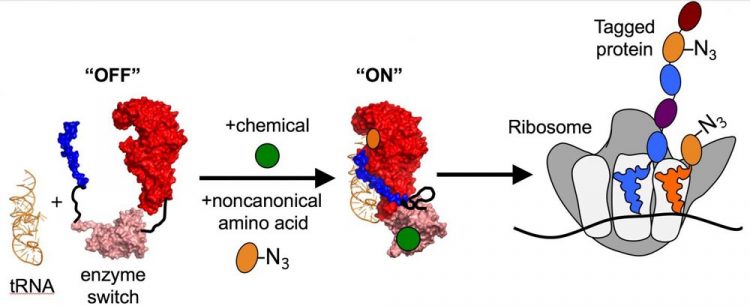Protein 'spy' gains new abilities

Rice University scientists have discovered a method to tag proteins with a controllable enzyme switch. When prompted, fragments of a tRNA synthetase come together and charge a tRNA with a bio-orthogonal amino acid (N3), which is inserted as a recognizable tag into all subsequent proteins made in the cell. Credit: The Silberg Research Group/Rice University
Rice University scientists have learned to spy on cells with a divide-and-conquer strategy to label proteins.
Graduate student Emily Thomas, synthetic biologist Jonathan Silberg and their colleagues built upon established techniques that attach bio-orthogonal (noninterfering), artificial amino acids to transfer RNA (tRNA), which are used by ribosomes to synthesize proteins.
Because the amino acids are “noncanonical,” they are effective tags that help researchers identify proteins being synthesized in a cell. The Rice lab's breakthrough was the discovery of a tRNA synthetase that only adds the amino acid to the tRNA when it binds a chemical. When prompted, the tRNA synthetase charges a tRNA with the bio-orthogonal amino acid, which is then used by ribosomes to insert the tag into proteins made in the cell.
The study appears in the American Chemical Society journal ACS Synthetic Biology.
These bio-orthogonal tags give researchers a snapshot of total protein synthesis in the cell. “Instead of physically separating a cell from a mixture to find the proteins being made, we can use this engineered switch to put what amounts to a fishhook on every protein in a specific cell,” Silberg said. “This approach will allow us to increase spatial and temporal control over the tagging of proteins synthesized in a given cell.”
Since many proteins appear and disappear during the development of an organism or the spread of a disease, the technique could be helpful to identify cellular changes that underlie disease. Thomas characterized her technique as a “protein spy.”
“It spies on what proteins are being made inside the cell,” she said. “Current technologies just spy on everything, but I want to be more specific. I want more control over when I turn my spy on or off, so I can track only the cells I'm interested in.”
The researchers used an azidonorleucine (Anl) amino acid to tag proteins in Escherichia coli bacteria cells. Thomas' engineered switch is controlled like a computer program's AND gate. The switch only charges tRNA with Anl efficiently when the switch is synthesized and a chemical is present in the cell to flip the switch.
Silberg said the technique will provide new control over protein transcription and tagging to researchers. “In human biology, a lot of the control comes at the DNA level, but over the past 20 years it's become apparent that a lot of control comes at the protein level as well,” he said. “We have fewer genes in our genome than people originally expected because there's this other layer of complexity in the proteome, the collection of proteins expressed by the genome.
“Proteins are the business side of the cell,” he said. “They provide structure and do a lot of the signaling within a cell. They give rise to a lot of the complexity we observe. In the future, our technique could help people understand the details of a disease by providing snapshots of proteins synthesized in specific cells at different times during development and allowing comparisons of healthy and diseased cells.
“The prospect of doing this in humans is the genetic technology equivalent of going to Mars right now,” Silberg said. “It's far out.”
###
Co-authors of the paper are Rice alumnus Naresh Pandey, graduate student Sarah Knudsen and Zachary Ball, an associate professor of chemistry. Silberg is an associate professor of biosciences.
The research was supported by the National Science Foundation, the Robert A. Welch Foundation, the John S. Dunn Collaborative Research Award, the National Aeronautics and Space Administration, the Keck Center of the Gulf Coast Consortia, the Houston Area Molecular Biophysics Program and the National Institute of General Medical Sciences.
Read the abstract at http://pubs.
This news release can be found online at http://news.
Follow Rice News and Media Relations via Twitter @RiceUNews
Related materials:
The Silberg Research Group: http://www.
Wiess School of Natural Sciences: http://natsci.
Located on a 300-acre forested campus in Houston, Rice University is consistently ranked among the nation's top 20 universities by U.S. News & World Report. Rice has highly respected schools of Architecture, Business, Continuing Studies, Engineering, Humanities, Music, Natural Sciences and Social Sciences and is home to the Baker Institute for Public Policy. With 3,879 undergraduates and 2,861 graduate students, Rice's undergraduate student-to-faculty ratio is 6-to-1. Its residential college system builds close-knit communities and lifelong friendships, just one reason why Rice is ranked No. 1 for happiest students and for lots of race/class interaction by the Princeton Review. Rice is also rated as a best value among private universities by Kiplinger's Personal Finance. To read “What they're saying about Rice,” go to http://tinyurl.
Media Contact
All latest news from the category: Life Sciences and Chemistry
Articles and reports from the Life Sciences and chemistry area deal with applied and basic research into modern biology, chemistry and human medicine.
Valuable information can be found on a range of life sciences fields including bacteriology, biochemistry, bionics, bioinformatics, biophysics, biotechnology, genetics, geobotany, human biology, marine biology, microbiology, molecular biology, cellular biology, zoology, bioinorganic chemistry, microchemistry and environmental chemistry.
Newest articles

Properties of new materials for microchips
… can now be measured well. Reseachers of Delft University of Technology demonstrated measuring performance properties of ultrathin silicon membranes. Making ever smaller and more powerful chips requires new ultrathin…

Floating solar’s potential
… to support sustainable development by addressing climate, water, and energy goals holistically. A new study published this week in Nature Energy raises the potential for floating solar photovoltaics (FPV)…

Skyrmions move at record speeds
… a step towards the computing of the future. An international research team led by scientists from the CNRS1 has discovered that the magnetic nanobubbles2 known as skyrmions can be…





















